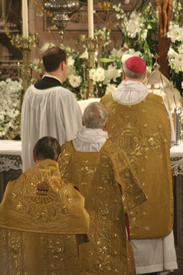The Mass: Overview
THERE ARE A VARIETY OF WAYS to celebrate the Mass. As Dom Gregory Dix tells us, "there is not one single way of 'doing this' absolutely identical throughout christendom." He adds that "none of the many ways of 'doing' it has anywhere remained the same from the days of the apostles until now. On the contrary, this simple bond of christian unity has a peculiarly complicated and ramifying history of variation."
Our way of "doing this," the way we at Ascension and Saint Agnes celebrate the Mass, reflects the rite established for use throughout the western church following the Council of Trent as expressed through the stately Cramnerian prose of the Anglican Book of Common Prayer.
There are two main divisions in the Mass itself. The first, a service of prayer, scripture-reading, psalms, and instruction, is known as the Synaxis, the Liturgy of the Word, or the Mass of the Catechumens. This is followed by the second, called the Eucharist, the Mass of the Faithful, or Holy Communion.
The first of the two main divisions of the Mass is preceded by prayerful preparation. Individually when we enter the church we bless ourselves with holy water as a reminder of our baptism, we reverence the Blessed Sacrament reserved in the tabernacle on the altar, and then kneel in our pew for a moment of silent personal prayer.
In the sacristy, the sacred ministers and other members of the altar party prayerfully vest themselves as the rubrics prescribe and then enter the sanctuary to begin the Asperges,which is sometimes preceded by a procession and usually followed by the formal prayer of the sacred ministers called "The Preparation."
The links in the navigation menu on the top right of your screen will take you to more information about the Entry and Preparation, the Mass of the Catachumens, and the Mass of the Faithful.
![]()
IF YOU ARE UNFAMILIAR with the the Mass, please keep in mind that eucharistic worship is not a private matter. It is necessarily and intentionally corporate. We gather not as a collection of unrelated, more-or-less pious individuals engaged merely in our own private prayer, but as the Church, united—in unum amor Christi—across generations, ethnicities, nationalities, social classes, political ideologies, and across the millenia as members of the Body of Christ. We gather with one another around our bishop, or the priest to whom our bishop has delegated his liturgical authority as celebrant, to make our united corporate prayer of praise and thanksgiving to God not only "for all the benefits he has done unto us" but for the ineffable love that is God Himself -- our most courteous Lord, who gently leads us and repeatedly calls us back to Himself.

